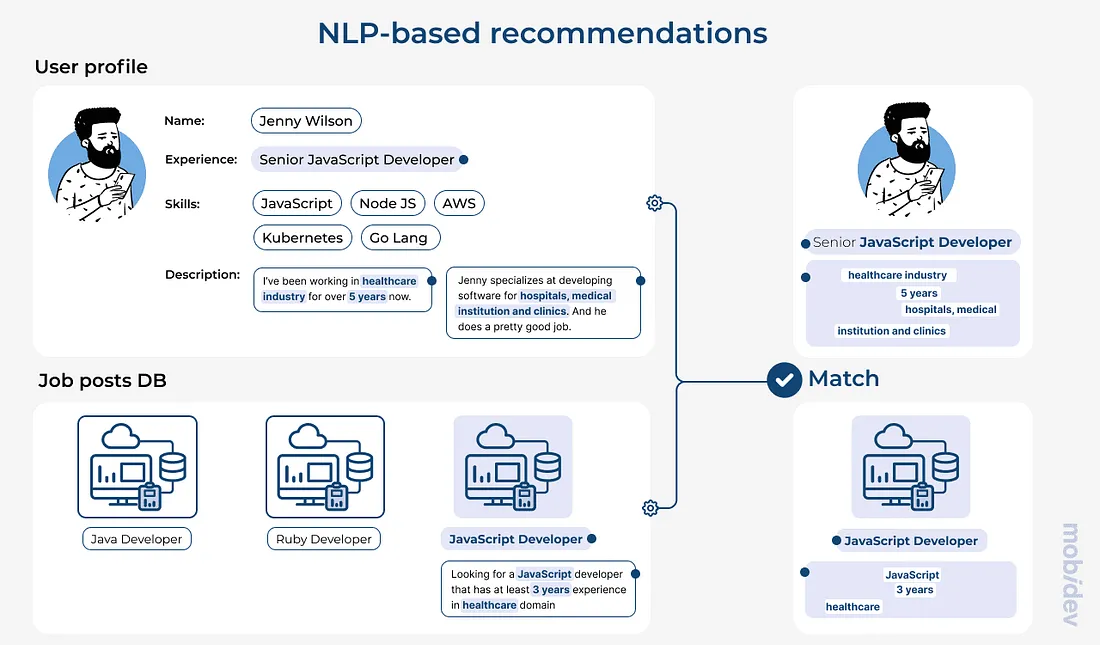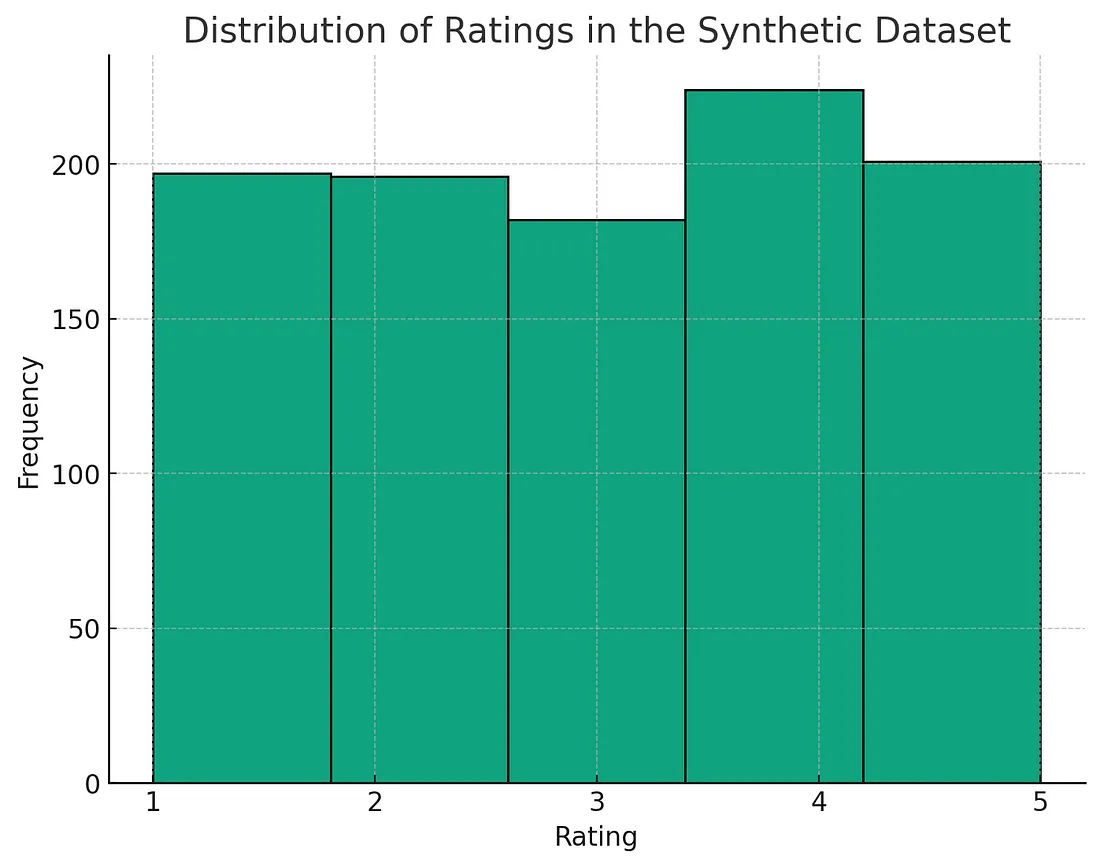通过自然语言处理增强推荐系统:协同方法
介绍
自然语言处理(NLP)是人工智能的一个分支,它专注于使机器能够以一种既有意义又有用的方式理解、解释和响应人类语言。它包括了一系列技术,包括情感分析、语言翻译和聊天机器人。
推荐系统(RecSys),另一方面,是旨在向用户推荐相关项目的算法。这些建议可以是各种项目,如电影、书籍、产品,甚至是社交媒体联系人。推荐系统通常是通过分析用户行为和偏好中的模式来运作的。
自然语言处理(NLP)与推荐系统(RecSys)间的关系是一个令人着迷且快速发展的研究领域,为提升用户体验和商业成果提供了重大潜力。本文探讨了这两个领域的交汇点,重点关注NLP如何丰富推荐系统,所面临的挑战和机遇,以及它们整合的未来前景。

NLP与RecSys的融合
NLP与RecSys的整合是一个自然的进展,因为它们有互补的能力。NLP通过分析语言来深入理解用户偏好,这可能包括产品评价、社交媒体帖子和搜索查询。这种理解可以显著提高RecSys中推荐的准确性和相关性。
NLP对RecSys的主要贡献:
- 增强的内容分析:NLP技术可以分析与项目相关的文本内容(如产品描述或电影剧本),以理解它们的上下文和主题,这可以改善基于内容的推荐。
- 情感分析:通过评估客户评论和反馈,NLP能确定对产品或服务的情绪,有助于推荐更可能被欣赏的项目。
- 个性化交互:由NLP提供动力的聊天机器人和语音助手可以与用户交互,收集偏好并提供个性化推荐。
- 改进的搜索功能:将NLP与推荐系统内的搜索引擎整合起来可以更好地理解用户查询,从而获得更准确的推荐。
整合的挑战
尽管潜在的好处很多,NLP与RecSys的整合也提出了一些挑战:
- 处理复杂性:NLP算法,特别是涉及深度学习的算法,可能计算上非常密集。
- 数据隐私和道德:使用NLP分析用户生成的内容引发了数据隐私和个人信息的道德使用问题。
- 上下文理解:理解人类语言的上下文和微妙之处,包括讽刺和习语,对NLP来说仍然是一个挑战。
- 多语言支持:开发能够在多种语言上有效工作的NLP工具是一个重大挑战,尤其是对于全球推荐系统来说。
代码
创建完整的Python实现来展示自然语言处理(NLP)与推荐系统(RecSys)之间的关系,使用合成数据集涉及几个步骤。我们将:
- 生成合成数据集。
- 实施基本的NLP技术来处理文本数据。
- 创建一个简单的推荐算法。
- 用图形显示结果。
步骤1:合成数据集的创建
我们将生成一个包含用户ID、项目ID(例如,产品、电影)、评分和文本评论的合成数据集。
步骤2:NLP处理
我们将应用基本的NLP技术来处理文本评论。这可能包括词汇化、情感分析或提取关键短语。
步骤3:推荐算法
我们将实现一个基础的推荐算法。这可能是一个基于内容的或协同过滤方法,通过NLP处理的洞察力增强。
步骤4:可视化
我们将创建图表来可视化结果,如显示评分分布或情感与用户偏好之间的关系。
让我们开始在Python中实现这些步骤。注意,由于完整RecSys的复杂性,我们将创建一个简化的版本以演示目的。

直方图提供了一个视觉表示,展现了评分在数据集中的分布情况。
import pandas as pd
import numpy as np
import matplotlib.pyplot as plt
from sklearn.feature_extraction.text import TfidfVectorizer
from sklearn.metrics.pairwise import cosine_similarity
# Step 1: Create a Synthetic Dataset
np.random.seed(42)
num_users = 100
num_items = 20
num_reviews = 1000
# Sample data
users = np.random.randint(1, num_users + 1, num_reviews)
items = np.random.randint(1, num_items + 1, num_reviews)
ratings = np.random.randint(1, 6, num_reviews) # Ratings between 1 and 5
reviews = ["This is a review about item " + str(item) for item in items]
# Create DataFrame
data = pd.DataFrame({
'user_id': users,
'item_id': items,
'rating': ratings,
'review': reviews
})
# Step 2: NLP Processing - TF-IDF Vectorization of Reviews
vectorizer = TfidfVectorizer(stop_words='english')
tfidf_matrix = vectorizer.fit_transform(data['review'])
# Step 3: Recommendation Algorithm - Content-Based Filtering
# Calculate cosine similarity between items
cosine_sim = cosine_similarity(tfidf_matrix, tfidf_matrix)
# Function to get recommendations for a given item
def get_recommendations(item_id, cosine_sim=cosine_sim):
# Get the index of the item that matches the item_id
idx = data[data['item_id'] == item_id].index[0]
# Get the pairwise similarity scores of all items with that item
sim_scores = list(enumerate(cosine_sim[idx]))
# Sort the items based on the similarity scores
sim_scores = sorted(sim_scores, key=lambda x: x[1], reverse=True)
# Get the scores of the 10 most similar items
sim_scores = sim_scores[1:11]
# Get the item indices
item_indices = [i[0] for i in sim_scores]
# Return the top 10 most similar items
return data['item_id'].iloc[item_indices]
# Step 4: Visualization
# Plotting the distribution of ratings
plt.figure(figsize=(8, 6))
plt.hist(data['rating'], bins=5, edgecolor='black')
plt.title('Distribution of Ratings in the Synthetic Dataset')
plt.xlabel('Rating')
plt.ylabel('Frequency')
plt.xticks(np.arange(1, 6, 1))
plt.show()
# For demonstration, let's show the recommendations for the first item in the dataset
recommendations = get_recommendations(1)
recommendations. Head()
此外,数据集中第一个项目(项目ID 1)的推荐已显示。这些建议基于文本内容的相似性,并展示了推荐系统(RecSys)如何利用自然语言处理(NLP)技术来提升其建议。
Result
2 8
3 8
8 9
9 5
10 6
Name: item_id, dtype: int64
需要注意的是,与现实世界的系统相比,这种实现非常简化,现实世界的系统通常会涉及更复杂的自然语言处理技术和推荐算法。然而,它作为一个基本的示例,展示了自然语言处理如何提升推荐系统的功能。
结论
自然语言处理与推荐系统之间的关系代表着一个充满活力和创新的领域,预示着如何转变用户与技术互动以及做出选择的方式。随着自然语言处理技术的进步,我们可以期待推荐系统变得更加直观、响应迅速且以用户为中心,从而为电子商务、娱乐等领域的应用开辟新的途径。在这一交叉点上的持续探索和发展无疑将为企业和消费者带来重大利益。































